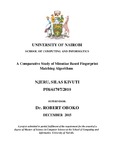| dc.description.abstract | The fingerprint recognition has been used widely in cross border identification, criminal investigation, access control and paternity identification among other modern identification and authentication systems. However, the complex distortions among the different fingerprint impression in real life poses a challenge in the performance of fingerprint recognition systems. Matching two fingerprints or finding duplicates in a large database of fingerprints can be difficult due to various reasons depending upon the method that is being used for matching. In the modern day technologies, various biometric identifiers e.g. iris, voice, fingerprints are considered more reliable for person recognition than traditional password or knowledge based methods because they cannot be easily misplaced, forged, or shared.
Previous research on this domain has only focused on comparing algorithms based on building confusion matrix or using false acceptance rate (FAR) and false rejects rates (FRR) which are measures of accuracy. In this research, we identified speed as another parameter in the comparative analysis. In our experiment, we compared two fingerprint matching algorithms by simulating the matching process of sampled fingerprint images. The process involved comparing each of the four (4) fingerprints from each individual with the entire set of other candidate fingerprints to identify duplicates if they exist. The output of a match comparison is either a positive match or a negative match. Based on the result of accuracy, time taken for matching, and the number of similar featured identified, the best algorithm was determined and a prototype system for de-duplication was developed. The two types of matching techniques used in this research were based on (a) matching using global orientation minutiae features and (b) matching using minutia triangulation technique. We conducted the experimental evaluation on a datasets of 100 candidates using four (4) fingerprints from each candidate. The data was sampled from a mass registration of citizen in Kenya conducted by a reputable organization.
The research revealed that fingerprint matching based on minutia triangulation algorithms performs better in terms of speed with an average of 38.32 milliseconds as compared to matching based on a combination of minutia and global orientation features with an average of 563.76 milliseconds. In terms of accuracy of matching, the algorithms based on a combination of minutia and global orientation field features performs better with an average similarity score of 0.142433 as compared to m-triplet based matching with an average similarity score of 0.004202. | en_US |



